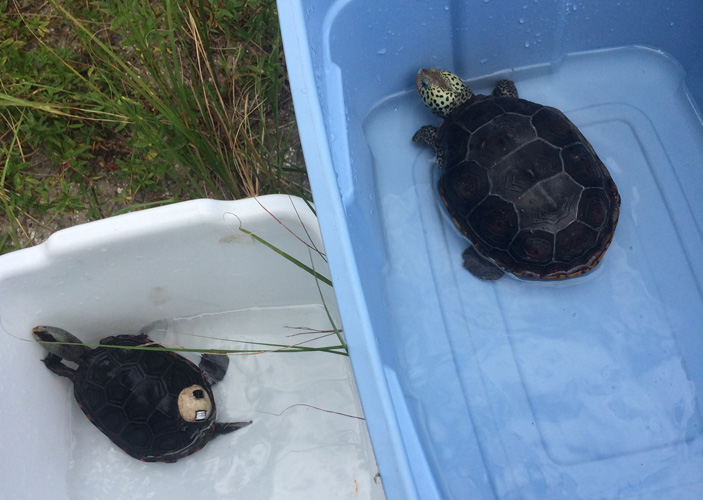
The nearly 12 miles of lagoon shoreline the Indian River Land Trust has acquired over the past decade or so was purchased mainly to protect the waterfront from development, but it also serves as a dynamic, living laboratory for research aimed at restoring the entire 156-mile-long estuary.
That research now includes an in-depth study looking at the population, range and diet of a little-understood brackish water turtle called the diamondback terrapin. The research is being conducted by Harbor Branch Oceanographic Institute graduate student Jeffrey Herr, who presented an outline of his study last week at the Indian River Lagoon Symposium 2020.
These small reptiles with distinctive markings range from Cape Cod, Massachusetts south around the Florida Peninsula, and north to Texas. Five of the animal’s seven subspecies live in Florida, including three that live only here. But scientists say they don’t know much about the Florida turtles’ population size and distribution, diet and genetics.
Looking to fill in those gaps in knowledge, Herr is conducting his research on Land Trust property on the barrier island north of the Barber Bridge.
Herr intends to track the animals’ movements, conduct a range-wide genetic analysis, collect blood samples and find out what exactly they eat.
“We’re still investigating stuff about their diet,” he said. “They eat things that eat seagrass, and that can be used to gauge the health of the ecosystem.”
Indeed, lagoon scientists consider seagrass to be the foundation of the lagoon ecosystem, which has suffered huge seagrass losses in recent years due to pollution and algae blooms.
So far, Herr has managed to capture 15 diamondback terrapins – eight males, seven females – in the lagoon in Vero Beach and attach acoustic tags on 12. He has deployed three receivers that track signals emitted by the tags when the animals are nearby. He has collected blood and tissue samples and some stomach contents.
The scientist has learned that his test subjects exhibit “high site fidelity” – 11 of the 12 have stayed in the area where they were tagged. But he hopes to deploy more tracking tags and work with the Atlantic Coast telemetry network – a consortium of scientists who have implanted tags in a variety of marine animals and built listening stations to detect them – to expand his knowledge of the turtles’ range.
Herr said the terrapins were very common until the late 19th century when they were overharvested for turtle soup. Commercial fishing for the turtles in Florida has been prohibited since the 1940s. Currently, they are not listed as imperiled in Florida, but state law limits harvest to one animal per day with no commercial sales. The International Union for Conservation of Nature (IUCN) classifies the diamondback terrapin as near threatened.
Herr said the biggest threat to the Florida turtles is from crab traps, which they swim into and then drown. He hopes to persuade state wildlife managers to require bycatch reduction devices on that fishing gear.
Meanwhile, Herr wants to learn all he can about the reptiles and asks that anyone who spots a diamondback terrapin notify him by emailing jherr2013@fau.edu.



